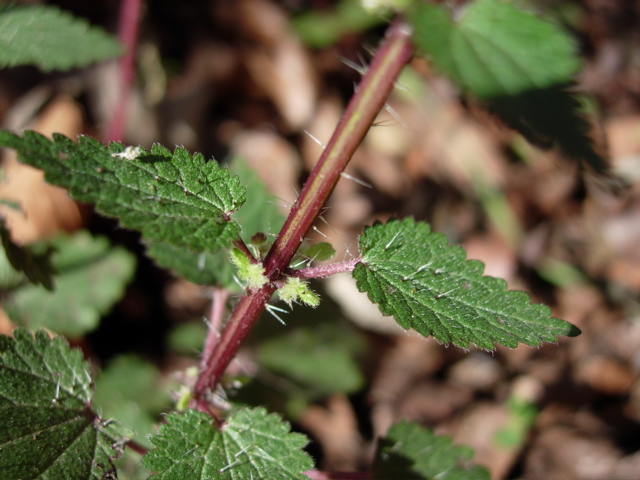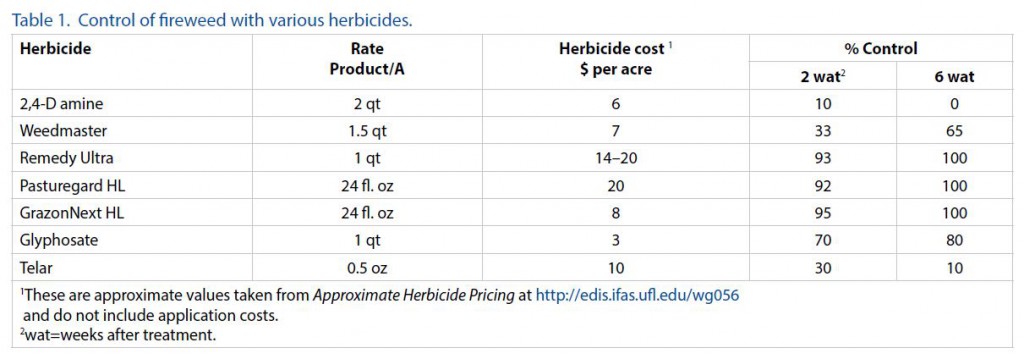
The fine hairs along the stem of Fireweed puncture the skin and introduce the toxin. Note the small flowers at the axil. Source: http://www.bio.utexas.edu/courses/bio406d/images/pics/urt/Urtica%20chamaedryoides.htm
Fireweed (Urtica chamaedryoides), may not be a pasture weed that causes great economic losses from competition, but it can cause distress to people who come in contact with it in their pastures or around the farm. Also known as heartleaf nettle, this plant is notorious for causing a burning sensation when it makes contact with bare skin.
Wendy B. Zomlefer shares in the publication “Stinging Nettles of Florida: Urtica” these details about the plant: “Irritant compounds (histamines and acetocholines) that cause reddening and intense itching fill the stiff, hypodermic-needle-like stinging hairs on the stem and leaves. When the tip of the brittle, tubular hair is broken, pressure on the bulbous hair base injects the irritants into the skin. The usual reaction, reddening and intense itching, is usually of short duration, although sensitive individuals may experience some swelling and burning. Washing the affected area, or immediate application of baking soda paste soothes the stinging sensation for most people.”
Although it is a winter annual, it can become a prolific plant that is often found on disturbed ground and livestock loafing areas, often in the barnyard, around fencelines, or around the base of trees. The leaves resemble that of a young strawberry plant. It has square stems and pale green flower clusters that are not showy but produce viable seed. The seed is surrounded by a sticky coating that adheres readily to mowers and animals. As a result, fireweed can easily move from spot to spot on a farm. According to the EDIS publication, Fireweed (Heartleaf Nettle) Control in Pastures, cattle tend to avoid it but horses may ingest it. It is better to be safe than sorry, so livestock producers should take every precaution to keep themselves and their animals from coming into contact with it.
![Picture of the Leaf Source: Wunderlin, R. P., and B. F. Hansen. 2008. Atlas of Florida Vascular Plants (http://florida.plantatlas.usf.edu/).[S. M. Landry and K. N. Campbell (application development), USF Water Institute.] Institute for Systematic Botany, University of South Florida, Tampa.](https://nwdistrict.ifas.ufl.edu/phag/files/2015/04/Urtica_chamaedryoides6-leaf-picture.jpg)
Picture of the Leaves
Source: Wunderlin, R. P., and B. F. Hansen. 2008. Atlas of Florida Vascular Plants (http://florida.plantatlas.usf.edu/).[S. M. Landry and K. N. Campbell (application development), USF Water Institute.] Institute for Systematic Botany, University of South Florida, Tampa.
Dr. Sellers and Dr. Ferrell (UF IFAS Weed Scientists) have this to say about the chemical controls: “It is our recommendation that GrazonNext HL, Remedy Ultra (or comparable triclopyr ester product), or Pasturegard HL be used for effective control of fireweed. These herbicides can be applied any time of year to warm-season forage grasses. There are no grazing restrictions for beef cattle with these herbicides, but lactating dairy animals must be removed for 0 and 14 days with GrazonNext HL and Remedy Ultra, respectively, and one season for Pasturegard HL.”
 Mowing may seem like a good way to control this weed, but unfortunately it results in smaller plants with more stinging hairs. Seed can adhere to the mower blades and be dispersed to non-affected areas.
Mowing may seem like a good way to control this weed, but unfortunately it results in smaller plants with more stinging hairs. Seed can adhere to the mower blades and be dispersed to non-affected areas.
For more information, use the following links:
Stinging Nettles of Florida: Urtica
Fireweed Control in Pastures
